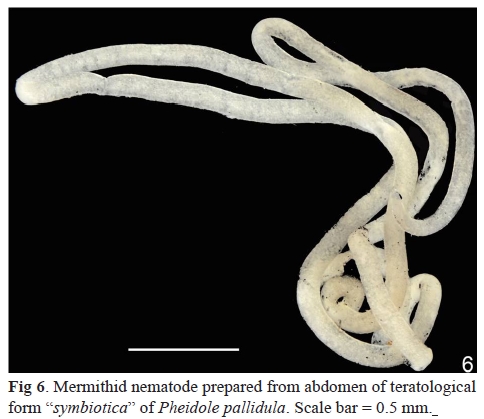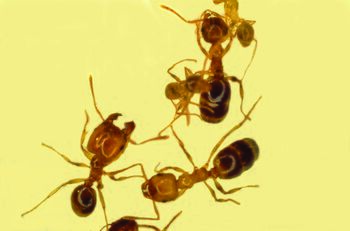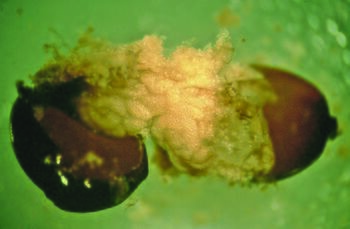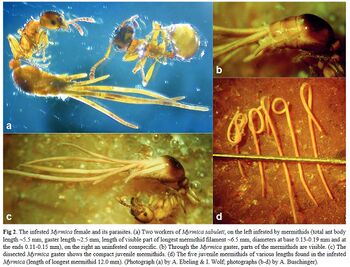Nematodes
Ants can serve as developmental, definitive, intermediate, or carrier hosts of a variety of nematodes. Parasitic ant nematodes include members of the families Mermithidae, Tetradonematidae, Allantonematidae, Seuratidae, Physalopteridae, Steinernematidae, and Heterorhabditidae. Those nematodes that are phoretically associated with ants, internally or externally, are represented by the Rhabditidae, Diplogastridae, and Panagrolaimidae. Fossils of mermithids, tetradonematids, allantonematids, and diplogastrids associated with ants show the evolutionary history of these relationships, some of which date back to the Eocene (40 mya). (Poinar, 2012)
Photo Gallery
Pheidole symbiotica
Borowiec and Salata (2015) found that the workers of the previously described species Pheidole symbiotica were simply workers of Pheidole pallidula that were infested with mermithid nematodes.
Sommimyrma symbiotica
Csosz (2012) - Bolton (1988) reported that the holotype of Sommimyrma symbiotica might have been a developmentally abnormal specimen, avoiding any further speculations. According to the images (Figs. 1a, b) probably two or three nematode worms (confirmed by nematologists, Gábor Majoros and George Poinar) nearly completely fill in the gaster of the type individual. The worms are not completely developed; these parasites apparently did not attain the preadult stage. In general characteristics of external morphology the symbiotica holotype specimen is reminiscent of the workers or mermithogenic phenotypes of Myrmica scabrinodis, hence I conducted a PCA based morphometric comparison of the type with both infested and uninfected classes of M. scabrinodis. Results demonstrate that M. symbiotica holotype is nested in the cluster of infested M. scabrinodis individuals (Fig. 2). Based on these results I propose new junior synonymy with M. scabrinodis.
Known Ant Hosts
| Ant | Nematode | Locality | Source | Notes |
|---|---|---|---|---|
| Acromyrmex crassispinus | Panagrolaimus sp. | Quevillon, 2018 | multiple encounter modes; indirect transmission; transmission outside nest | |
| Acromyrmex octospinosus | Steinerema carpocapsae | Quevillon, 2018 | multiple encounter modes; indirect transmission; transmission outside nest | |
| Aphaenogaster subterranea | Mermithidae (unspecified "Mermix") | Germany (Wuerzburg) | Gösswald, 1938; Laciny, 2021 | |
| Atta cephalotes | Panagrolaimus sp. | Quevillon, 2018 | multiple encounter modes; indirect transmission; transmission outside nest | |
| Atta cephalotes | Pristonchus sp. | Quevillon, 2018 | multiple encounter modes; indirect transmission; transmission outside nest | |
| Azteca | Diploscapter lycostoma | Quevillon, 2018 | multiple encounter modes; indirect transmission; transmission outside nest | |
| Azteca alpha | Formicodiplogaster myrmenema | Dominican amber | Poinar, 2011 | Dominican amber |
| Camponotus aethiops | Camponotimermis bifidus | Ipateva et al., 1990 | ||
| Camponotus aethiops | Comanimermis clujensis | Coman, 1953 | ||
| Camponotus atriceps | Mermithidae (unspecified "Mermix") | Mexico | Wheeler, 1933; Laciny, 2021 | as ''Camponotus abdominalis stercorarius'' |
| Camponotus castaneus | Rabbium paradoxus | Florida, United States | Poinar et al., 1989 | |
| Camponotus claripes | Mermithidae (unspecified "Mermix") | Australia (NSW) | Wheeler, 1933; Laciny, 2021 | |
| Camponotus consobrinus | Mermithidae (unspecified "Mermix") | Australia (NSW) | Wheeler, 1933; Laciny, 2021 | |
| Camponotus herculeanus | Mermithidae (unspecified "Mermix") | Italy | Finzi, 1930; Laciny, 2021 | |
| Camponotus herculeanus | Oscheius dolichura | Quevillon, 2018 | multiple encounter modes; indirect transmission; transmission outside nest | |
| Camponotus herculeanus | Oscheius dolichura | Ontario | Nickle & Ayre, 1966 | |
| Camponotus pompeius cassius | Mermithidae (unspecified "Mermix") | Congo | Wheeler, 1928; Laciny, 2021 | |
| Camponotus punctulatus minutior | Mermithidae (unspecified "Mermix") | Argentina | Wheeler, 1929; Laciny, 2021 | |
| Camponotus vicinus | Formicitylenchus oregonensis | Oregon, USA | Poinar, 2003 | |
| Cephalotes atratus | Myrmeconema neotropicum | Peru, Panama | Poinar & Yanoviak, 2008 | |
| Cephalotes minutus | Agamomermis cephaloti | Brazil | Poinar et al., 2006 | |
| Cephalotes serratus | Myrmeconema antiqua | Quevillon, 2018 | encounter mode unknown; indirect transmission; transmission outside nest | |
| Cephalotes serratus | Palaeoallantonema cephalotae | Dominican amber | Poinar, 2011; Quevillon, 2018 | Dominican amber; encounter mode unknown; indirect transmission; transmission outside nest |
| Cladomyrma | Diploscapter sp. | Quevillon, 2018 | multiple encounter modes; indirect transmission; transmission outside nest | |
| Cladomyrma | Sclerorhabditis sp. | Quevillon, 2018 | multiple encounter modes; indirect transmission; transmission outside nest | |
| Colobopsis | Mermithidae (unspecified "Mermis") | Papua New Guinea | Maeyama et al., 1994 Laciny, 2021 | |
| Colobopsis | Mermithidae (unspecified taxon) | Brunei, KBFSC | Laciny et al., 2017 | ant identified as ''Colobopsis'' sp. nrSA |
| Crematogaster | Diploscapter sp. | Quevillon, 2018 | multiple encounter modes; indirect transmission; transmission outside nest | |
| Crematogaster | Sclerorhabditis sp. | Quevillon, 2018 | multiple encounter modes; indirect transmission; transmission outside nest | |
| Eciton burchellii | Agamomermis ecitoni | Venezuela | Poinar et al., 2006 | |
| Ectatomma ruidum | Meximermis ectatommi | Mexico | Poinar et al., 2006 | see also Weber, 1946 (Trinidad) |
| Ectatomma tuberculatum | Mermis sp. | Quevillon, 2018 | encounter mode secondary; indirect transmission; transmission outside nest | |
| Ectatomma tuberculatum | Mermithidae (unspecified "Mermix") | Panama, Trinidad | Wheeler, 1930; Laciny, 2021 | |
| Ectatomma tuberculatum | unidentified nematode | French Guiana | ||
| Formica | Diploscapter lycostoma | Quevillon, 2018 | multiple encounter modes; indirect transmission; transmission outside nest | |
| Formica | Diploscapter lycostoma | Wahab, 1962 | ||
| Formica fusca | Comanimermis clujensis | Coman, 1953 | ||
| Formica fusca | Mermithidae (unspecified "Mermix") | Germany | Gosswald, 1930; Laciny, 2021 | |
| Formica polyctena | Oscheius dolichura | Quevillon, 2018 | multiple encounter modes; indirect transmission; transmission outside nest | |
| Formica rufibarbis | Mermithidae (unspecified "Mermix") | Germany | Gosswald, 1930; Laciny, 2021 | |
| Lasius | Diploscapter lycostoma | Quevillon, 2018 | multiple encounter modes; indirect transmission; transmission outside nest | |
| Lasius | Diploscapter lycostoma | Wahab, 1962 | ||
| Lasius | Koerneria histophora | Wahab, 1962 | ||
| Lasius | Pheromermis myrmecophila | Crawley & Baylis, 1921 | ||
| Lasius | Pheromermis myrmecophila | Quevillon, 2018 | encounter mode secondary; indirect transmission; transmission outside nest | |
| Lasius | Pristionchus lheritieri | Quevillon, 2018 | multiple encounter modes; indirect transmission; transmission outside nest | |
| Lasius | Pristionchus lheritieri | Wahab, 1962 | ||
| Lasius alienus | "Mermis" | England (Oxford, Cornwal) | Crawley & Baylis, 1921 | |
| Lasius alienus | Mermis myrmecophila | Germany | Gosswald, 1929; Laciny, 2021 | |
| Lasius alienus | Mermithidae (unspecified "Mermix") | Germany (Wuerzburg) | Gösswald, 1938; Laciny, 2021 | |
| Lasius americanus | Allomermis (sensu Cobb) | Massachusetts, United States | Wheeler, 1928; Laciny, 2021 | |
| Lasius brevicornis | Allomermis (sensu Cobb) | Massachusetts, United States | Wheeler, 1928; Laciny, 2021 | |
| Lasius brunneus | Diplogasteroides spengelii | Kohler, 2012 | ||
| Lasius brunneus | Diplogasteroides spengelli | Quevillon, 2018 | multiple encounter modes; indirect transmission; transmission outside nest | |
| Lasius brunneus | Diploscapter sp. | Kohler, 2012 | ||
| Lasius brunneus | Halicephalobus similigaster | Kohler, 2012 | ||
| Lasius brunneus | Koerneria histophora | Kohler, 2012 | ||
| Lasius brunneus | Oscheius dolichura | Kohler, 2012 | ||
| Lasius brunneus | Oscheius dolichura | Quevillon, 2018 | multiple encounter modes; indirect transmission; transmission outside nest | |
| Lasius claviger | Oscheius dolichura | Nickle & Ayre, 1966 | ||
| Lasius claviger | Oscheius dolichura | Quevillon, 2018 | multiple encounter modes; indirect transmission; transmission outside nest | |
| Lasius flavus | "Mermis" | England (Oxford, Cornwal) | Crawley & Baylis, 1921 | |
| Lasius flavus | Mermithidae (unspecified "Mermix") | Germany (Wuerzburg) | Gösswald, 1938; Laciny, 2021 | |
| Lasius flavus | Oscheius dolichura | Janet, 1893; Wahab, 1962 | ||
| Lasius flavus | Oscheius dolichura | Quevillon, 2018 | multiple encounter modes; indirect transmission; transmission outside nest | |
| Lasius flavus | Pheromermis myrmecophila | Ireland | O'Rourke, 1946; O’Grady & Breen, 2011; Laciny, 2021 | |
| Lasius flavus | Pheromermis villosa | Austria | Kaiser, 1986a, 1986b | |
| Lasius neoniger | Mermithidae (unspecified "Mermix") | Europe | Wheeler, 1928; Laciny, 2021 | |
| Lasius niger | "Mermis" | England (Oxford, Cornwal) | Crawley & Baylis, 1921 | |
| Lasius niger | Mermithidae (Pheromermis sp.?) | Austria, Burgenland | Laciny, 2017 | |
| Lasius niger | Mermithidae (unspecified "Mermix") | Germany (Wuerzburg) | Gösswald, 1938; Laciny, 2021 | |
| Lasius niger | Oscheius dolichura | Quevillon, 2018 | multiple encounter modes; indirect transmission; transmission outside nest | |
| Lasius niger | Pheromermis lasiusi | Rubstov, 1970 | ||
| Lasius niger | Pheromermis myrmecophila | Ireland | O'Rourke, 1946; O’Grady & Breen, 2011; Laciny, 2021 | |
| Lasius niger | Pheromermis villosa | Austria | Kaiser, 1986a, 1986b | |
| Leptothorax acervorum | Mermithidae (unspecified "Mermix") | Germany | Gosswald, 1930; Laciny, 2021 | |
| Linepithema | Heydenius myrmecophila | Quevillon, 2018 | encounter mode unknown; indirect transmission; transmission outside nest | |
| Linepithema | Heydenius myrmecophila | Dominican amber | Poinar et al., 2006 | Dominican amber fossil |
| Linepithema humile | Diploscapter lycostoma | Markin & McCoy, 1968 | ||
| Myrmecia forficata | Mermithidae (unspecified "Mermix") | Australia (Victoria) | Wheeler, 1933; Laciny, 2021 | |
| Myrmica | Steinerema carpocapsae | Quevillon, 2018 | multiple encounter modes; indirect transmission; transmission outside nest | |
| Myrmica gallienii | Mermithidae (unspec.) | Hungary | Csosz & Majoros, 2009; Laciny, 2021 | |
| Myrmica rubra | Mermithidae (unspec.) | Poland | Czechowsk et al., 2007; Laciny, 2021 | |
| Myrmica rubra | Mermithidae (unspecified "Mermix") | Germany | Gosswald, 1930; Laciny, 2021 | |
| Myrmica ruginodis | Mermithidae (unspecified "Mermix") | Germany | Gosswald, 1930; Laciny, 2021 | |
| Myrmica rugulosa | Diploscapter lycostoma | Wahab, 1962 | ||
| Myrmica rugulosa | Mermithidae (unspec.) | Poland | Czechowsk et al., 2007; Laciny, 2021 | |
| Myrmica rugulosa | Mermithidae (unspecified "Mermix") | Germany | Gosswald, 1930; Laciny, 2021 | |
| Myrmica sabuleti | Hexamermis/Agamermis | Germany | Steiner et al., 2019; Laciny, 2021 | |
| Myrmica sabuleti | Mermithidae (unspec.) | Poland | Czechowsk et al., 2007; Laciny, 2021 | |
| Myrmica scabrinodis | "Mermis" | Hungary, France, Austria, Italy | Csosz, 2012; Laciny, 2021 | infected ant described as ''Sommimyrma symbiotica'', now ''Myrmica scabrinodis'' |
| Myrmica scabrinodis | Mermithidae (unspecified "Mermix") | Germany | Gosswald, 1930; Laciny, 2021 | |
| Myrmica schencki | Mermithidae (unspecified "Mermix") | Germany | Gosswald, 1930; Laciny, 2021 | |
| Myrmica sulcinodis | "Mermis" | Hungary, France, Austria, Italy | Radchenko & Elmes, 2003; Csosz, 2012; Laciny, 2021 | |
| Neoponera inversa | Mermithidae (unspecified "Mermix") | Colombia | Wheeler, 1928; Laciny, 2021 | |
| Neoponera villosa | Mermithidae (unspecified "Mermix") | Neotropics | Wheeler, 1928; Laciny, 2021 | |
| Odontomachus chelifer | Mermithidae (unspecified "Mermix") | Neotropics | Wheeler, 1928; Laciny, 2021 | |
| Odontomachus haematodus | Mermithidae (unspecified "Mermix") | Neotropics | Wheeler, 1928; Laciny, 2021 | |
| Odontomachus hastatus | Agamomermis costaricensis | Costa Rica | Poinar et al., 2006 | |
| Pachycondyla fuscoatra | Mermithidae (unspecified "Mermix") | Neotropics | Wheeler, 1928; Laciny, 2021 | |
| Pachycondyla striata | Mermithidae (Mermithidae (unspecified "Mermis") | Paraguay | Strelnikov, 1928; Laciny, 2021 | |
| Paraponera clavata | Mermithidae (unspecified "Mermix") | Neotropics | Wheeler, 1928; Laciny, 2021 | |
| Pheidole absurda | Mermithidae (unspecified "Mermix") | Neotropics | Wheeler, 1928; Laciny, 2021 | |
| Pheidole dentata | Mermithidae (unspecified "Mermix") | Texas, United States | Wheeler, 1901; Wheeler, 1928; Laciny, 2021 | as ''Pheidole commutata'' |
| Pheidole gouldi | Mermithidae (unspecified "Mermix") | Guatemala | Wheeler, 1928; Laciny, 2021 | |
| Pheidole pallidula | Hexamermis | France | Passera, 1976; Laciny, 2021 | |
| Pheidole pallidula | Mermithidae (unspecified "Mermix") | France | Wheeler, 1928; Laciny, 2021 | |
| Pheidole sauberi | Mermithidae (species unspecified) | Philippines | General & Buenavente, 2021 | |
| Pheidole susannae | Mermithidae (unspecified "Mermix") | Guatemala | Wheeler, 1928; Laciny, 2021 | |
| Pheidole vorax | Mermithidae (unspecified "Mermix") | Guatemala | Wheeler, 1928; Laciny, 2021 | |
| Pogonomyrmex | Steinerema carpocapsae | Quevillon, 2018 | multiple encounter modes; indirect transmission; transmission outside nest | |
| Pogonomyrmex barbatus | Skrjabinoptera phrynosoma | Texas, United States | Lee, 1957 | |
| Polyrhachis delecta | Mermithidae (unspec.) | Australia (N. Queensland) | Downes, 2017; Laciny, 2021 | |
| Polyrhachis monteithi | Mermithidae (unspec.) | Australia (N. Queensland) | Downes, 2017; Laciny, 2021 | |
| Prenolepis henschei | Heydenius formicinus | Baltic amber | Poinar, 2002 | Baltic amber fossil |
| Prolasius advena | Diploscapter formicidae | Quevillon, 2018 | multiple encounter modes; indirect transmission; transmission outside nest | |
| Prolasius advena | Diploscapter formicidae | New Zealand | Zhao et al., 2013 | |
| Solenopsis | Steinerema carpocapsae | Quevillon, 2018 | multiple encounter modes; indirect transmission; transmission outside nest | |
| Solenopsis fugax | Mermithidae (unspecified "Mermix") | Germany | Gosswald, 1930; Laciny, 2021 | |
| Solenopsis fugax | Mermix | Germany | Gosswald, 1929; Laciny, 2021 | |
| Solenopsis geminata | Mermithidae (unspec.) | USA, Florida | McInnes & Tschinkel, 1996; Laciny, 2021 | |
| Solenopsis geminata | Mermithidae (unspec.) | USA, Florida | Mitchell & Jouvenaz, 1985; Laciny, 2021 | |
| Solenopsis geminata | Steinerema carpocapsae | Quevillon, 2018 | multiple encounter modes; indirect transmission; transmission outside nest | |
| Solenopsis invicta | Allomermis solenopsi | Argentina | Poinar et al., 2007; Laciny, 2021 | |
| Solenopsis invicta | Diploscapter sp. | Quevillon, 2018 | multiple encounter modes; indirect transmission; transmission outside nest | |
| Solenopsis invicta | Heterorhabditis bacteriophora | Quevillon, 2018 | multiple encounter modes; indirect transmission; transmission outside nest | |
| Solenopsis invicta | Mermithidae (unspec.) | USA, Florida | McInnes & Tschinkel, 1996; Laciny, 2021 | |
| Solenopsis invicta | Mesorhabditis longespiculosa | Quevillon, 2018 | multiple encounter modes; indirect transmission; transmission outside nest | |
| Solenopsis invicta | Oscheius dolichura | Quevillon, 2018 | multiple encounter modes; indirect transmission; transmission outside nest | |
| Solenopsis invicta | Sclerorhabditis sp. | Quevillon, 2018 | multiple encounter modes; indirect transmission; transmission outside nest | |
| Solenopsis invicta | Steinerema carpocapsae | Quevillon, 2018 | multiple encounter modes; indirect transmission; transmission outside nest | |
| Solenopsis invicta | Steinernema carpocapsae | Poinar, 2012 | ||
| Solenopsis invicta | Tetradonema solenopsis | Brazil | Nickle & Jouvenaz, 1987 | |
| Solenopsis pergandei | Mermithidae (unspec.) | USA, Florida | McInnes & Tschinkel, 1996; Laciny, 2021 | |
| Solenopsis richteri | Heterorhabditis bacteriophora | Quevillon, 2018 | multiple encounter modes; indirect transmission; transmission outside nest | |
| Solenopsis richteri | Steinerema carpocapsae | Quevillon, 2018 | multiple encounter modes; indirect transmission; transmission outside nest | |
| Solenopsis richteri | Tetradonema solenopsis | Argentina | Jouvenaz & Wojcik, 1990 | |
| Temnothorax interruptus | Mermithidae (unspecified "Mermix") | Germany | Gosswald, 1930; Laciny, 2021 | |
| Temnothorax ravouxi | Mermithidae (unspecified "Mermix") | Germany | Gosswald, 1930; Laciny, 2021 | as ''Epimyrma gösswaldi'' |
| Temnothorax tuberum | Mermithidae (unspecified "Mermix") | Germany | Gosswald, 1930; Laciny, 2021 | |
| Temnothorax unifasciatus | Mermithidae (unspecified "Mermix") | Germany | Gosswald, 1930; Laciny, 2021 | |
| Tetramorium caespitum | Mermithidae (unspecified "Mermix") | Germany (Wuerzburg) | Gösswald, 1938; Laciny, 2021 | |
| Tetramorium caespitum | Mermithidae (unspecified "Mermix") | Switzerland (Wallis) | Kutter, 1958; Laciny, 2021 | |
| Tetramorium caespitum | Oscheius dolichura | Quevillon, 2018 | multiple encounter modes; indirect transmission; transmission outside nest | |
| Tetramorium caespitum | Oscheius dolichura | Wahab, 1962 |
References
- Borowiec, L. & Salata, S. 2015. Pheidole symbiotica Wasmann, 1909, an enigmatic supposed social parasite, is a nematode infested form of Pheidole pallidula (Nylander, 1849) (Hymenoptera: Formicidae: Myrmicinae). Sociobiology, 62, 181-186 (doi:10.13102/sociobiology.v62i2.181-186).
- Csősz, S. 2012. Nematode infection as significant source of unjustified taxonomic descriptions in ants (Hymenoptera: Formicidae). Myrmecological News, 17, 27-31.
- Poinar, G., Jr. 2012. Nematode parasites and associates of ants: Past and present. Psyche, 2012, Article ID 192017, 13 pages (DOI 10.1155/2012/192017).
- Steiner, F.M., Kohler, G., Seifert, B., Arthofer, W., Schlick-Steiner, B.C., Buschinger, A. 2019. A worker-like female of Myrmica sabuleti Meinert, 1861 (Hymenoptera: Formicidae: Myrmicinae) in a pitfall trap with five mermithids (Nematoda: Mermithidae) protruding from the gaster. Sociobiology 66(3): 400-407 (doi:10.13102/sociobiology.v66i3.4338).
| ||||||||||||||||||||||||||||||||||||||||||||||||||||||||



















